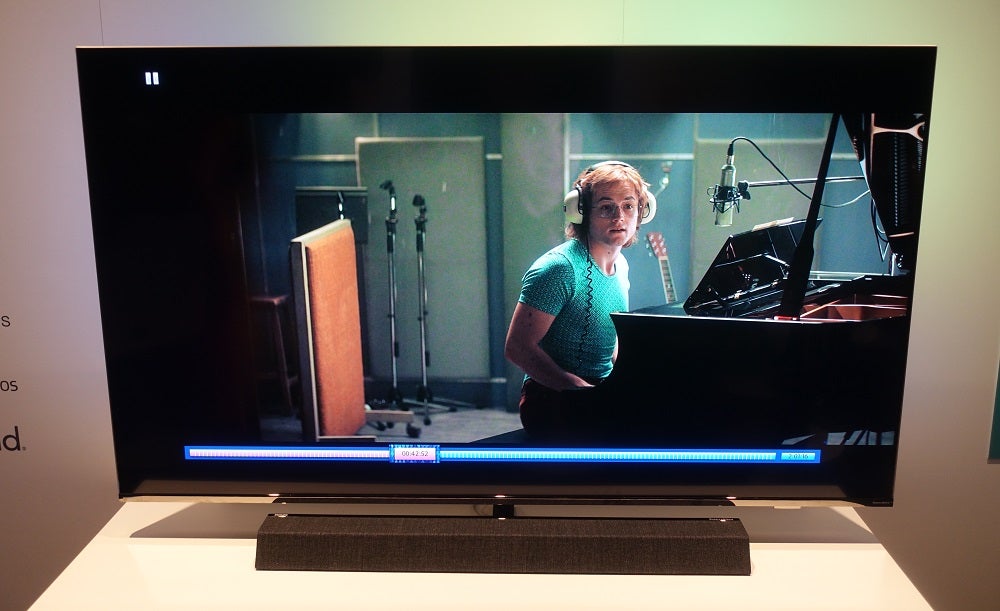Philips TV 2021: Everything you need to know about Philips’ OLED, Mini LED and Ambilight TVs
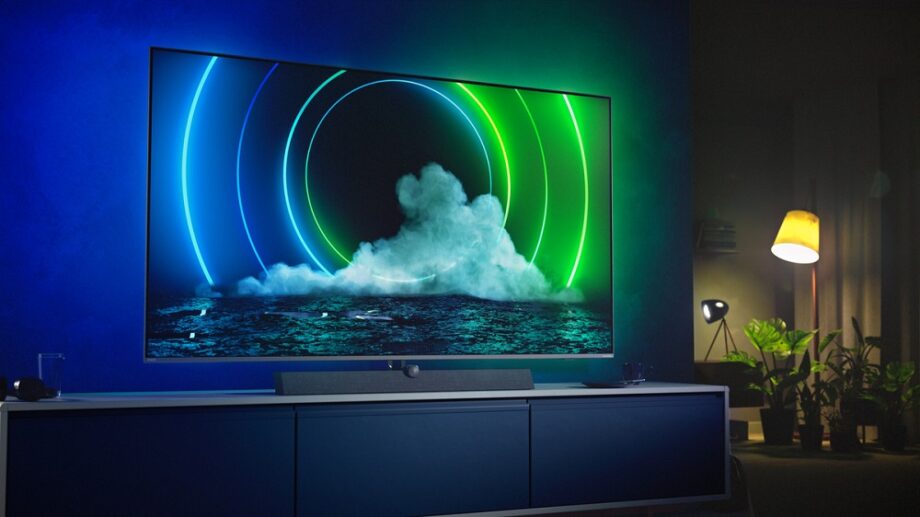
Here’s what you need to know about Philips TV for 2021. Philips’ TV range is the home of Ambilight, and this year will see bigger OLED sizes and brand new Mini LED TVs join the line-up.
We’ll be listing every TV from the affordable sets up to the premium displays. Be sure to check this page throughout the year, as we’ll update this guide with more information about release dates and prices as we learn them.
New Philips TV for 2021
Mini LED joins the Philips family of TVs, promising thin screens and blazing HDR brightness. However, Philips won’t be wading into the 8K with no models on the horizon.
Otherwise, OLED continues as the flagship experience, with the OLED+935 crossing over into 2021 to be replaced later in the year. Arriving in the summer are new OLEDs in smaller and bigger sizes, as well two ‘unannounced’ models in the OLED706/705 that look to be the most affordable OLED in Philips’ range.
The Performance Series – also known as The One – is back to serve as the main mainstream option with its balance of affordability and premium specs.
Philips goes bigger with its 77-inch OLED
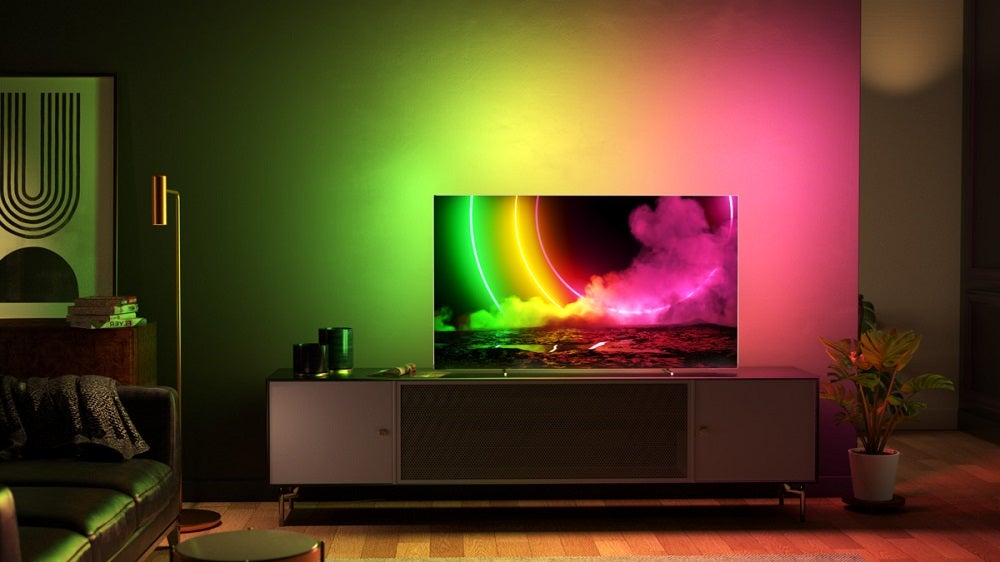
After a few years of 55- and 65-inch OLEDs, 2020 saw the introduction of a smaller 48-inch model and for 2021 Philips will release a 77-inch model.
While not as big as LG or Sony’s 83-inch efforts, it’s the biggest OLED in Philips’ line-up. For customers who enjoy watching big-screen films on an OLED with Ambilight serving as the backdrop, this would be the size to get. Only the OLED806 series gets the 77-inch model.
Philips launches first Mini LED TVs
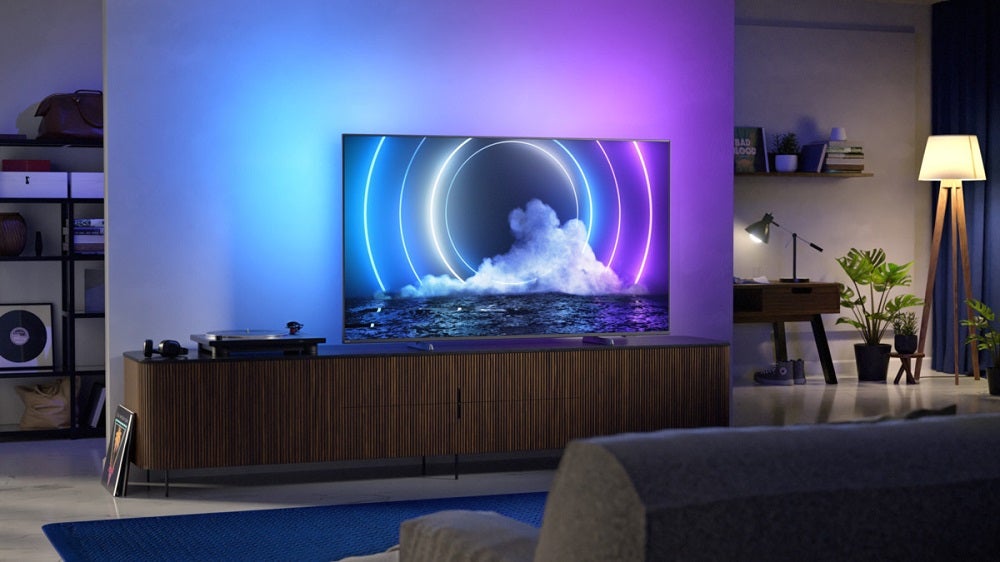
2021 will be the year Mini LED arrives in the UK. Philips is bringing two models to the market – the 9636 and 9506 – in 65- and 75-inch sizes. They’ll combine a local dimming backlight with Philips’ Micro Dimming Premium system for deeper black levels and bright highlights with the 9635 aiming to hit a peak brightness of 2000 nits.
Philips says these models will use a “high quality” VA panel for wider viewing angles, and a wide colour gamut that hits 95% of the DCI-P3 spectrum for accurate colours.
Full speed ahead with next-gen gaming
Philips’ latency of their premium TVs has always lagged behind their competitors, but that should change in 2021.
From the OLED856 to the 9206, 4K/120Hz, Auto Low Latency Mode (ALLM), Variable Refresh Rate (VRR) and AMD’s FreeSync Premium Pro will be supported. Philips is finally a TV tuned for gamers.
5th Gen P5 AI picture processor
The new P5 AI Intelligent Picture Engine uses neural networks and machine learning to adjust the balance between Philips’ five pillars of PQ – source, colour, contrast, motion and sharpness – for a more realistic and natural image.
An additional sixth category has been added in Film detection. Film Detection flags any movie content, giving the viewer the chance to switch to a new Home Cinema Mode, Pure Cinema Mode or Filmmaker Mode. Speaking of Filmmaker Mode, it will be a named picture preset so the viewers can actually select it from the menu.
The new P5 supports HDR10, HLG, HDR10+ and the new HDR10+ Adaptive format. Dolby Vision is onboard, and the 5th Gen P5 continues to improve upon that content in that format with its Dolby Vision Bright mode. Dolby Vision IQ is not supported, but Philips did mention the TV’s light sensor in combination with the Bright Mode should result in a similar experience.
The new Fast Motion Clarity feature has only been announced for the OLED 800 series, but it serves to avoid the motion blurring effect for a gradual transition from one image to the next.
Anti burn-in solution on more OLEDs
Burn in refers to static images being permanently retained in the screen over long periods of time. The OLED806/856 will get a version of Philips’ anti-burn technology that uses an advanced logo detection to detect static content and gradually reduce its intensity to avoid this. It aims do so without compromising the brightness in other parts of the screen, and worked well on the OLED+935.
Philips TV 2021
Philips TV OLED
OLED856
- 55OLED856
- 65OLED856
The OLED856 has a more advanced version of the P5 AI Engine, now onto its 5th incarnation. The new processor has a Film Detection mode for identifying movie content, and boosts its HDR support with the inclusion of the HDR10+ Adaptive format, optimising brightness levels of HDR10+ content in sync with room levels so the viewer can catch more detail and see the impact of HDR at its best.
The OLED856/806 also comes with a version of Philips’ anti-burn in technology that detects static logos and reduces the light output to avoid burn in. Where the OLED856 differs from the 806 is its T-bar stand, which will give it a higher profile in a room.
Advancements over the 2020 OLED+935 include HDMI 2.1 capability that makes this OLED better suited for gaming, while the OS is Android TV 10 (no confirmation as to whether Google TV is coming yet).
- P5 AI Intelligent Picture Engine
- Android TV 10
- HLG, HDR10, HDR10+, HDR10+ Adaptive, Dolby Vision
- 2.1 50W sound system
- Dolby Atmos
- DTS Play-Fi
- 4K/120fps, eARC, VRR, ALLM
- AMD FreeSync Pro
- Four-sided Ambilight
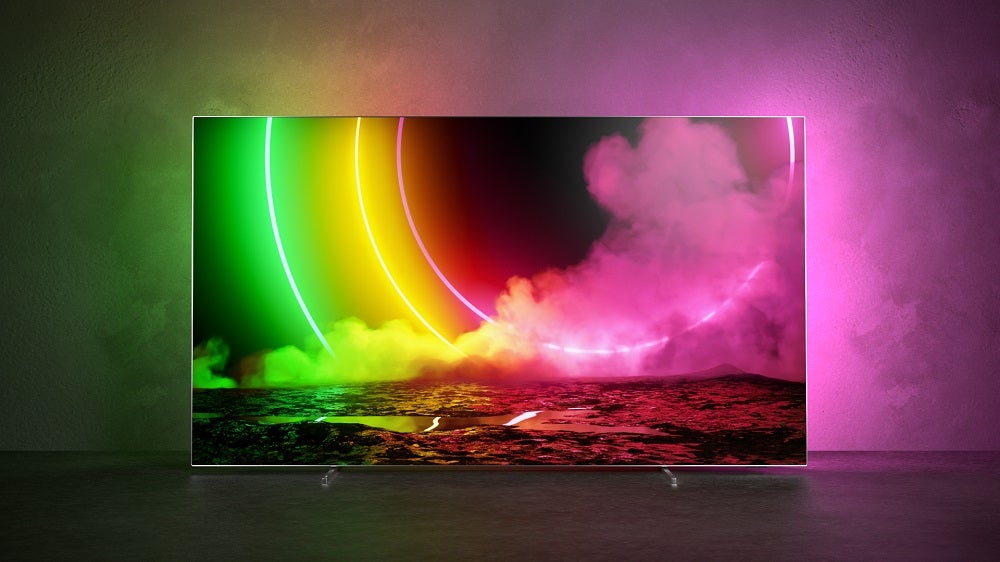
OLED806
- 48OLED806
- 55OLED806
- 65OLED806
- 77OLED806
The OLED806 replaces the outgoing OLED805 and benefits from more sizes, including a 48-inch and 77-inch model. It matches the OLED856 for picture, sound, smart and gaming features, as well as getting Philips’ premium remote control wrapped in responsibly sourced leather from Scottish specialists Muirhead. The stand is the biggest change, the OLED806 having dual blade ‘sticks’ for its feet for a lower profile in a room.
- P5 AI Intelligent Picture Engine
- Android TV 10
- HLG, HDR10, HDR10+, HDR10+ Adaptive, Dolby Vision
- 2.1 50W sound system
- DTS Play-Fi
- Dolby Atmos
- 4K/120fps, eARC, VRR, ALLM
- AMD FreeSync Pro
- Four-sided Ambilight
OLED 706
- 55OLED706
- 55OLED706
Philips has not officially announced the OLED706, which gives us the impression it’s due later in the year and likely the re-introduction of its cheaper OLED model (like the OLED754). Its specification is a near match for the OLED806, from its P5 AI processor down to its 50W 2.1 sound system. The biggest differences we can tell are the three-sided Ambilight and a less premium remote.
We’d speculate that some of the 800 series OLED features, such as the Fast Motion Clarity, may not make it to this model. No release date or price has been revealed yet.
- P5 AI Intelligent Picture Engine
- Android TV 10
- HLG, HDR10, HDR10+, Dolby Vision
- 2.1, 50W sound system
- Dolby Atmos
- DTS Play-Fi
- 4K/120fps, eARC, VRR, ALLM
- Three-sided Ambilight
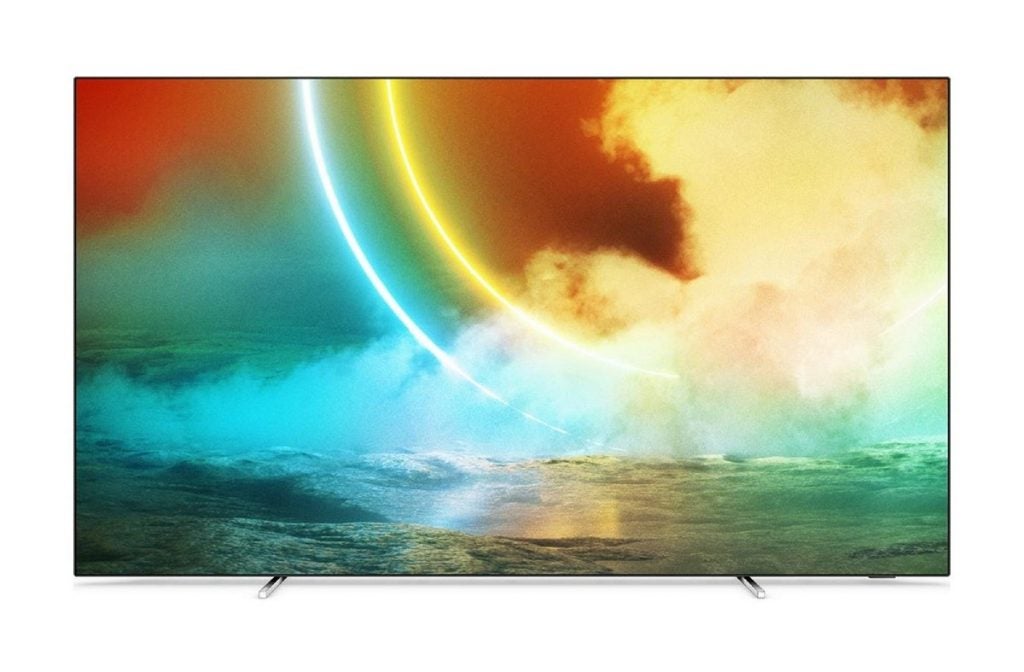
OLED705
- 55OLED705
- 65OLED705
All the announced (and unannounced) 2021 OLED models feature the ‘6’ suffix, so the OLED705 lead us to imagine it has more in common with the 2020 TVs.
It is available and – at the moment – is the cheapest OLED on the market with the 55-inch version priced at £999. The 705 has the P5 Perfect Engine, so no AI picture smarts on this set. The operating system is Android TV 9, and it features HDMI 2.0 with ARC connectivity. The sound system is not as powerful as the above models at 40W, and Ambilight is available in its three-sided form.
- P5 Perfect Picture Engine
- Android TV 9
- HLG, HDR10, HDR10+, Dolby Vision
- 2.1 40W sound system
- Dolby Atmos
- DTS Play-Fi
- ARC
- Three-sided Ambilight
Philips TV Mini LED 9000 series
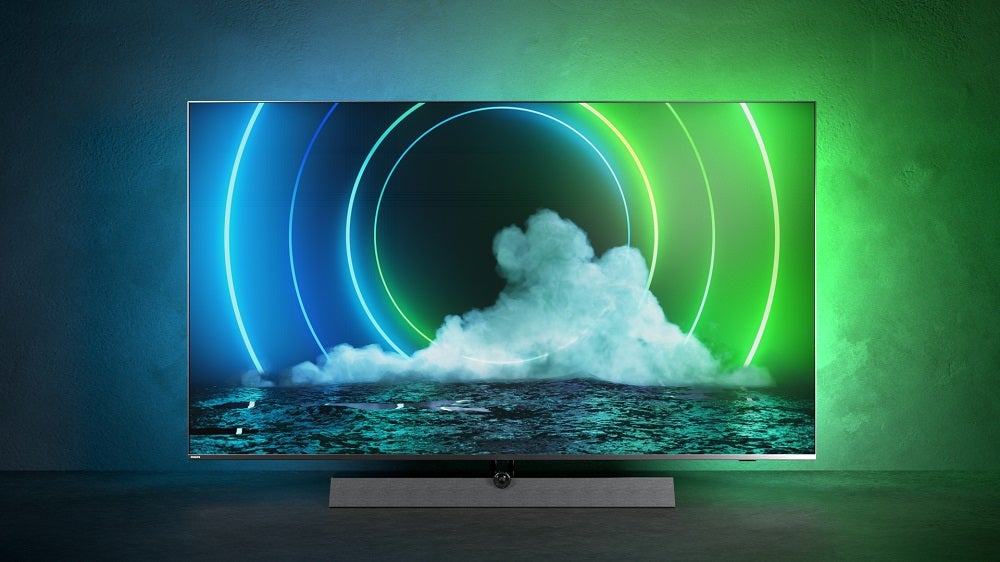
Mini LED 9636
- 65PUS9636/12
- 75PUS9636/12
Philips’ first Mini LED TV is the 9635. Like the OLED+ series it gets an integrated 3.1.2 B&W Atmos sound system. DTS Play-Fi covers Hi-Res audio support and multi-room capabilities.
Philips’ Micro Dimming Pro tech aims for deep black levels and high contrast, with the panel can generate a peak brightness of 2000 nits with HDR content. The use of a high-quality VA panel should offer wider viewing angles, and Philips claims the TV covers 95% of the DCI-P3 spectrum for more accurate colours.
The 5th Gen P5 AI engine powers the show and includes the Film Detection feature, as well as working with the set’s light sensor to tweak images depending on room brightness. In terms of gaming, this Mini LED is up to date with the latest trends and adds AMD’s FreeSync Premium Pro for reducing tearing and stutter. The Auto Game Mode should help reduce latency compared to the 2020 TVs.
- P5 AI Intelligent Picture Engine
- Android TV 10
- Bowers & Wilkins 3.1.2 Atmos sound system
- HLG, HDR10, HDR10+, HDR10+ Adaptive, Dolby Vision
- DTS Play-Fi
- 4K/120fps, eARC, VRR, ALLM
- AMD FreeSync Pro
- Four-sided Ambilight
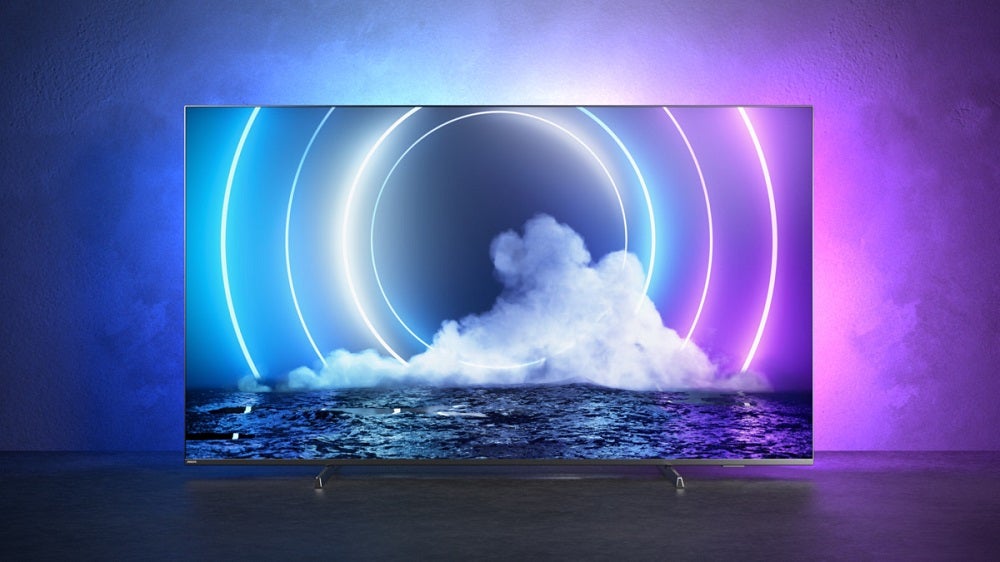
Mini LED 9506
- 65PUS9506/12
- 75PUS9506/12
The step-down Mini LED carries the same features as the above flagship 9636 but adopts features a change in its stand, with blade ‘sticks’ instead of a centrally mounted option. There’s no integrated B&W sound system, using a 50W 2.1 system with a rear mounted woofer for bass.
The P5 AI Engine packs the same advanced features seen in the above, while peak brightness drops to 1500 nits for a still intense but less fiery HDR picture quality. Gaming performance ought to be consistent too, and there’s support for the next-gen HDMI 2.1 features in eARC and VRR.
- P5 AI Intelligent Picture Engine
- Android TV 10
- 50W 2.1 sound system
- HLG, HDR10, HDR10+, HDR10+ Adaptive, Dolby Vision
- Dolby Atmos
- DTS Play-Fi
- 4K/120fps, eARC, VRR, ALLM
- AMD FreeSync Pro
- Four-sided Ambilight
Philips TV 4K LED
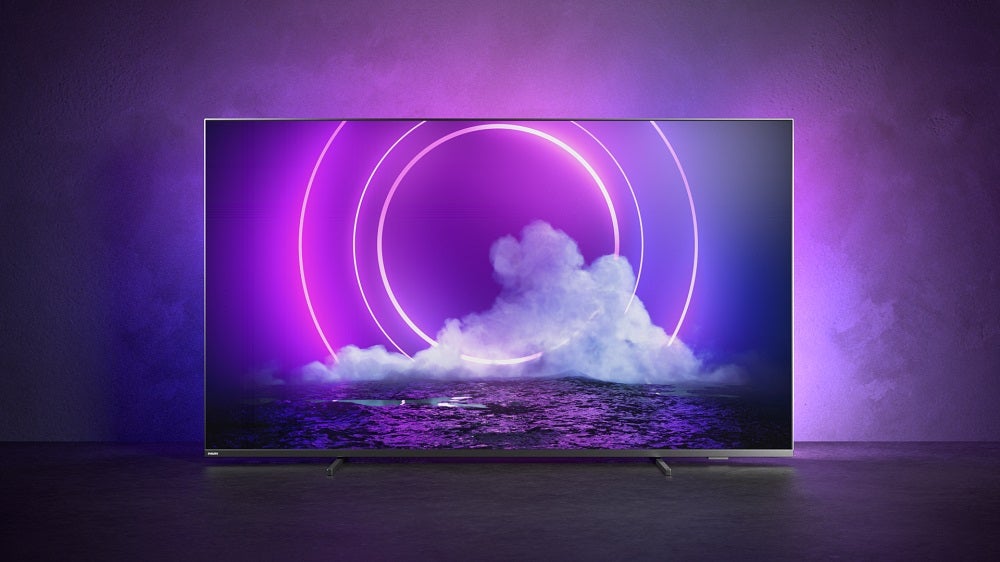
9206
- 55PUS9206/12
- 65PUS9206/12
With the 9206 we move into Philips’ LED range. While the elegant design remains, performance and features drop.
The 9206 is armed with a 100Hz VA panel for wide viewing angles. It features Philips’ Micro Dimming Pro system, but we’d expect the performance is less impactful than the Mini LEDs. That’ll likely be true of the picture engine too, which loses the AI processing and the ability to upscale SDR images to HDR.
From a games perspective the 9206 gets VRR, ALLM and AMD’s FreeSync Pro. The 50W 2.1 sound system matches the 9506 Mini LED with its rear mounted woofer and patented triple ring technology for enhanced bass. This is the first TV in the range that isn’t CalMAN ready for anyone interested in picture calibration up to a professional standard.
- P5 Perfect Picture Engine
- Android TV 10
- 50W 2.1 sound system
- HLG, HDR10, HDR10+, HDR10+ Adaptive, Dolby Vision
- Dolby Atmos
- DTS Play-Fi
- 4K/120fps, eARC, VRR, ALLM
- AMD FreeSync Pro
- Four-sided Ambilight
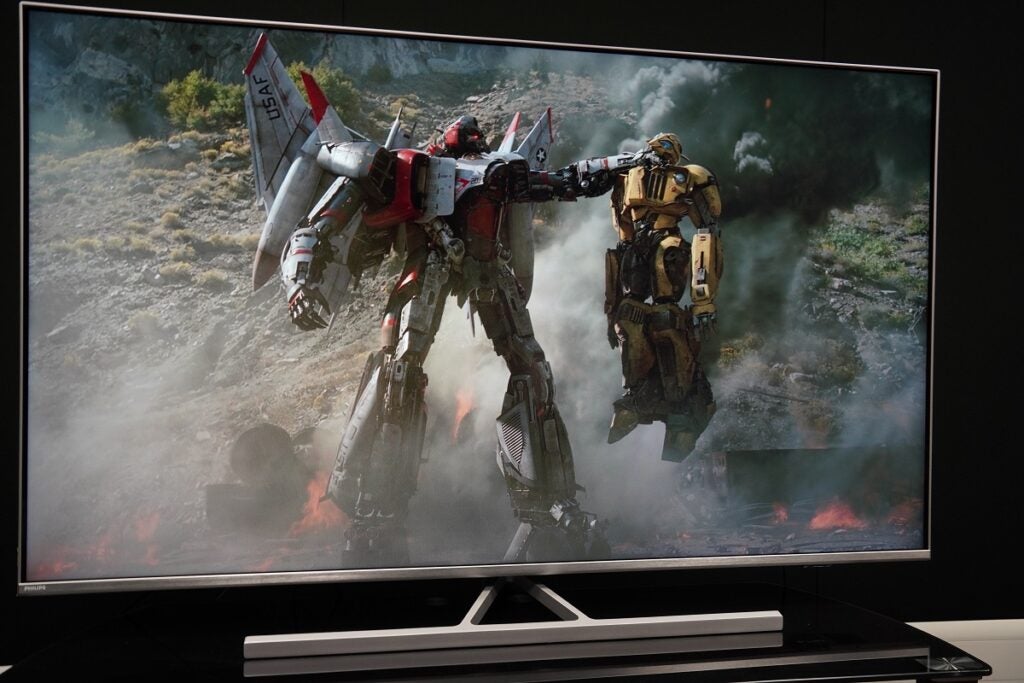
The One 8506
- 43PUS8506/12
- 50PUS8506/12
- 58PUS8506/12
- 65PUS8506/12
- 70PUS8506/12
- 75PUS8506/12
The 8506 series is Philips’ affordable range of TVs aimed at the mainstream buyer. They’re available in many sizes and carry some of the premium features seen in the TVs above.
The 43- to 65-inch models get a T-bar stand for support, with the sizes up to 58-inches getting swivel action. The biggest models in the range switch to feet at either side that can adjusted to narrow or wide configurations.
The Direct LED screen features Philips’ Micro Dimming system, but not the Pro version, so expect black levels and contrast to drop with this model. There’s no 4K/120 support but VRR, ALLM and eARC are all onboard and the audio is a standard 2.0 20W system. The Ambilight lighting system is present in its three-sided variant.
read our Philips PUS8506 review
- P5 Perfect Picture Engine
- Android TV 10
- HLG, HDR10, HDR10+, Dolby Vision
- Dolby Atmos
- DTS Play-Fi
- eARC, VRR, ALLM
- Three-sided Ambilight
7906
- 43PUS7906/12
- 50PUS7906/12
- 55PUS7906/12
- 65PUS7906/12
- 70PUS7906/12
- 75PUS8506/12
Sitting below ‘The One’ is the 7906. The AmbiSleep/Sunrise feature where the TV can emit a warm glow and sounds in the morning/night is left out. The picture processor drops to the Pixel Plus Ultra HD, and motion interpolation is only available on the 70- and 75-inch models.
Philips’ TV App collection is left out, though we can’t imagine many will be crestfallen by that. There is VRR but no eARC or an auto low latency mode.
- Pixel Plus Ultra HD
- Android TV 10
- 20W 2.0 sound system
- HLG, HDR10, HDR10+, Dolby Vision
- Dolby Atmos
- ARC, VRR
- Three-sided Ambilight
7506
- 43PUS7506/12
- 50PUS7506/12
- 55PUS7506/12
- 65PUS7506/12
At the bottom of the range is the 7506. It boasts a better specification than the 7906 in a few respects, evident by the P5 Perfect Engine processor, DTS Play-Fi, as well as HDMI 2.1 support in VRR, eARC and ALLM.
In other respects, it’s clear why this is at the bottom. There’s no Android TV, replaced by the Saphi interface. That means no built-in Chromecast, Google Assistant, or the Google Play Store, but the set will support major SVOD apps in Netflix and Disney+. There’s no Ambilight, and the number of HDMI inputs drops to three.
- P5 Perfect Engine
- Saphi OS
- 20W 2.0 sound system
- HLG, HDR10, HDR10+, Dolby Vision
- Dolby Atmos
- eARC, VRR, ALLM
That’s all the information we have about the Philips TV line-up for 2021. Read on for details of their 2020 TVs that are still on sale.
Philips TV 2020 — 4K OLED
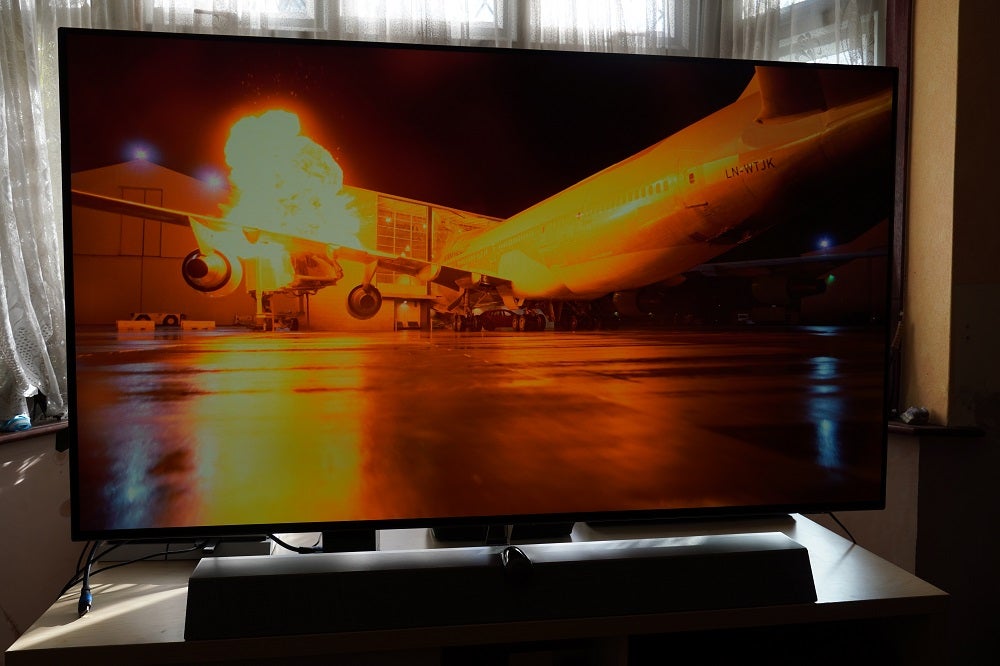
OLED+935
- 48OLED+935
- 55OLED+935
- 65OLED+935
For the time being, the OLED+935 continues through to 2021 with its successor likely coming in the second half of the year. The OLED+935 has the 4th Gen P5 AI processor with its dedicated AI Machine Learn Sharpness function, and improved versions of the AI Smart Bit Enhancement system and Perfect Natural Reality (PNR) function for upscaling sub-4K images and handling motion.
The TV also has the anti-burn that detects logos/static content onscreen to reduce the brightness of those static elements. There’s also DTS Play-Fi too, offering multi-room and High-Res music compatibility, and the set’s audio is provided by a Bowers & Wilkins 3.1.2 Atmos sound system.
- P5 AI Intelligent Dual Picture Engine
- Android TV 9
- Bowers & Wilkins 3.1.2 Atmos sound system
- HLG, HDR10, HDR10+, Dolby Vision
- DTS Play-Fi
- ARC
- Four-sided Ambilight
- read our Philips 65OLED+935 review
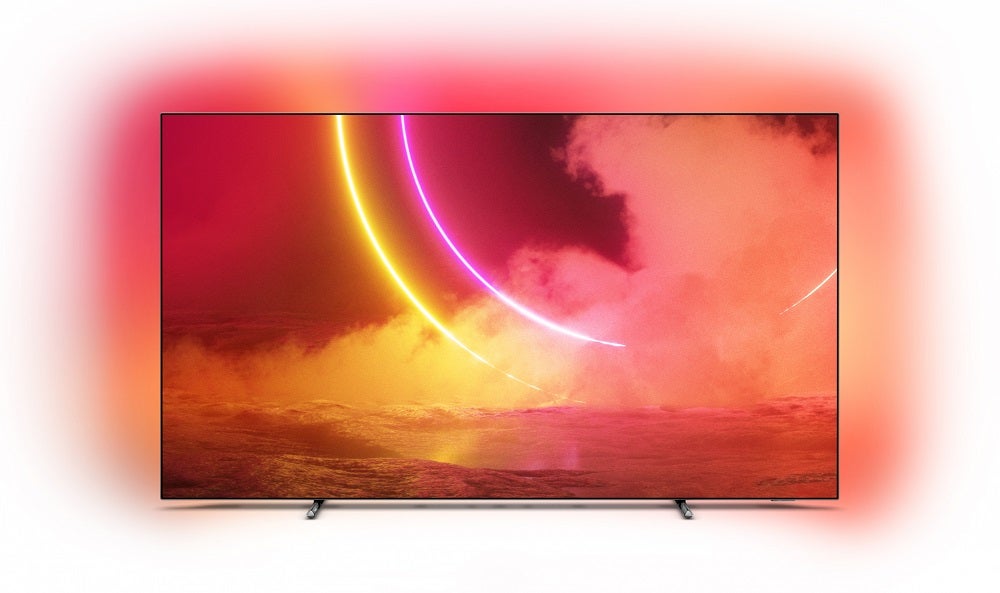
OLED805
- 55OLED805/12
- 65OLED805/12
The OLED805 has the same features and picture quality as the OLED855. The major difference is the design. The OLED855 opts for a central pedestal; the OLED805 features feet, or as Philips describes them “dark chrome sticks”.
- read our Philips OLED805 review
Philips TV 2020 — 4K LED
9435
- 55PUS9435/12
- 65PUS9345/12
Philips’ collaboration with B&W continues with the 9435 LED screen, with Bowers producing a speaker enclosure.
The speaker is in a 2.1.2 configuration and supports Dolby Atmos. Brightness is around 500 nits, and the TV packs in support for HDR10, HLG, HDR10+ and Dolby Vision.
- read our Philips 55PPUS9435 hands-on review
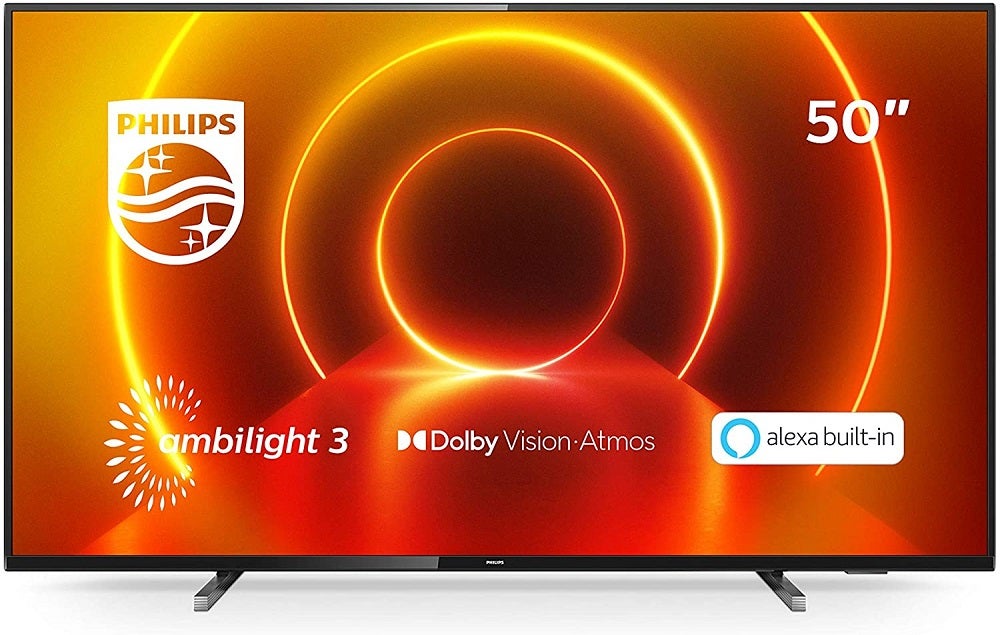
7805 (7800 Series)
- 43PUS7804/12
- 50PUS7804/12
- 55PUS7804/12
- 58PUS7804/12
- 65PUS7804/12
- 70PUS7835/12
- 75PUS7835/12
Philips hasn’t announced any TVs lower than the 7805, so we assume this is the entry-level set for 2020. The 7805 range is also known as 7804 and 7835,
Features fall off at this point, but it is available in more sizes, with the 7804 covering 43- to 65-inches and the 7835 70- to 75-inches. The number of HDMI ports stands at 3, the smart interface is the Saphi OS. It does not support Disney+, but does feature the likes of YouTube, Netflix, Rakuten TV and Prime Video. There’s no built-in voice assistance either.


